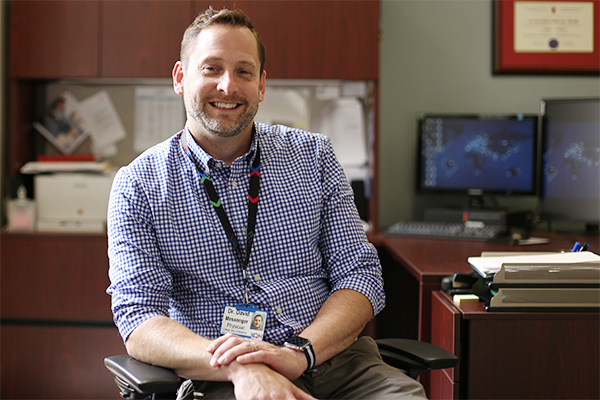Working Toward Inclusion: Listening to LGBTQI2S+ Student Voices in Medicine
June 28, 2019
Share

This guest blog, written by Dr. David Messenger, an emergency and intensive care physician and head of the Department of Emergency Medicine at Queen’s University, was first published on the Faculty of Health Sciences Dean’s Blog.
Recently, I took part in a panel discussion organized by Queen’s medical students. A small group of faculty and resident physicians came together to speak about our individual experiences as LGBTQI2S+ persons in medical school, residency training and early practice. As the oldest panelist, I looked forward to learning how different becoming an LGBTQI2S+ doctor must be now compared to my own experience.
When I started medical school at Queen’s in 1998, the landscape looked much different than it does today. Sexual orientation had only just been added to the Canadian Human Rights Act; same-sex marriage rights were still seven years away. At 21, I had yet to come out to my family and many friends, and I had just started my first gay relationship (with my now-husband). I was keenly aware of a need to tread very carefully as I took my first tentative steps out of a meticulously-constructed closet.
As a gay medical student, I felt relatively isolated. Rather than seek community with the tiny group of visible LGBTQI2S+ med students, I avoided associations that might result in my being “outed”. I felt certain that coming out would be a liability to any number of my ambitions in medicine, particularly matching to a competitive specialty residency program. I worried about how I’d be viewed and treated by preceptors, colleagues, and by patients if I presented as anything other than the norm that was modeled for me in medicine. Gay clinical faculty exemplars or mentors? None were visible to me through my decade of training at Queen’s. Normalization of LGBTQI2S+ patients in the curriculum? Other than being taught to ask “do you have sex with men, women, or both?” when taking a sexual history, and discussions about gay patients in the context of HIV, I don’t recall much explicit reassurance that medicine welcomed the inclusion of the LGBTQI2S+ experience in its ranks.
Despite a sense of isolation, my actual lived experience at Queen’s has been mostly positive. My coming out has been a gradual and continuing experience that started during residency. I feel immensely grateful for the acceptance and support that I’ve received from many peers and mentors here who have proved to be committed allies as I’ve become more open with my identity. But my experience has always felt more like good luck than it has deliberate institutional culture.
Two decades later, it’s clear that much has changed. Listening to the contemporary stories and experiences of my co-panelists and others revealed that LGBTQI2S+ students are more comfortable living that identity openly among their peers today. A more visible and supportive LGBTQI2S+ medical student community exists for those who seek it out. This community is finding a voice that is helping to promote the inclusion of more diversity in the curriculum.
But, even now, LGBTQI2S+ students describe considerable apprehension about if and how to be themselves when applying for residency training. They search for subtle signals during electives and interviews that prospective programs are safe to join. They consider redacting their CVs to exclude activities that brand them as “too political” (code for “too gay”). They speak of ruling out entire disciplines from their career choices because of worry that as LGBTQI2S+, they won’t fit with the culture of the specialty. Despite unique individual experiences, many learners describe being victim to assumptions, misunderstandings, and a hidden curriculum that can make them feel like outsiders within their disciplines. And finally, they expose an ongoing scarcity of accessible and visible LGBTQI2S+ mentors and role models within Queen’s Medicine.
June is Pride month – among other things, a celebration of diversity. At Queen’s, we often discuss a need to foster diversity and inclusion in medicine, but the stories of our LGBTQI2S+ students and trainees bring to light how much work remains for diversity and inclusion to become lived values.
An inclusive medical school welcomes and normalizes as many different populations of students as possible. An inclusive medical school does not explicitly or implicitly marginalize people or label them as “other”, including the patients our graduates will go on to care for. As one of a small number of gay faculty members in a position of leadership, my visibility and accessibility to students is an important contribution I can make to help us be a more inclusive community. I have a tendency to shelter behind my ability to visibly “blend into the crowd” and to obscure my identity – some habits die hard – and that tendency might be sending the wrong message to my students and colleagues.
Change begins with recognition. We all need to pay attention to the stories of LGBTQI2S+ students, stories as diverse as the individuals who tell them. We can and must do better as allies, and this starts by listening to, learning from, and advocating for our students and colleagues’ experiences in medicine at Queen’s.